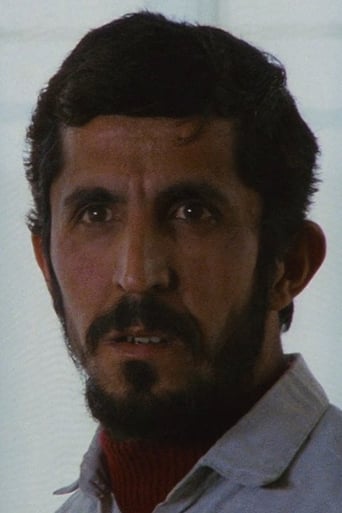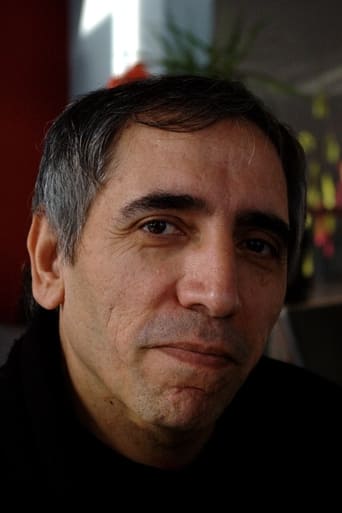Nonureva
Really Surprised!
Odelecol
Pretty good movie overall. First half was nothing special but it got better as it went along.
Fatma Suarez
The movie's neither hopeful in contrived ways, nor hopeless in different contrived ways. Somehow it manages to be wonderful
Geraldine
The story, direction, characters, and writing/dialogue is akin to taking a tranquilizer shot to the neck, but everything else was so well done.
aharunilhan-578-619044
Beside entertainment side, cinema has a massive potential of having a journey to either someone's life or ours. After some point, borders between someone or us disappear. That point is where cinema starts to reach its real meaning. Abbas Kiarostami's 1990 made film 'Nema-ye Nazdik - Close-Up' starts its journey in a police station and passes to our lives through the life of a 'film director'. Like a wide angle shot which zooms in for a close-up to our hearts. Similiar to Werner Herzog's characters, Husain Sabzian (acts for himself) becomes named as a fraud and a criminal. With the extraordinary effort of Kiarostami, we as the audience see beyond all these titles like fraud or criminal. Distinct way of filmmaking makes the film a documentary-fiction as the story and some of the shots are from real footages. Pretending like Mohsen Makhmalbaf is the heaven of Sabzian in this world. When police comes to arrest him, Sabzian becomes pulled to the earth from the sky, just like falling of the director character of Fellini's cult film, Otto Mezzo (1963). Directors are like patterns or samples of the God in the world. Adaptation to the realities of social world is the hardest part for any human who has a sharp emotional sensitivity like Sabzian has. In the court scene, when Sabzian succeds to tell why he had lied, we understand that everyone has the potential of this sensitivity and it is possible to transfer to someone else. That is why, Fellini's character Guido can never give up trying to tell what he wants to film. This seems to be the controversy all Sabzians will encounter through the life. With his pure intentions, Sabzian made everyone understand how 'thin' we can be. Will we succed to be that 'thin'?
Ricc0
The plot is quite simple.. Hussein Sabzian a cinephile, impersonates his favorite director Mohsen Makhmalbaf and enters the house of a well-to-do family convincing them that they would star in his next movie. After few meetings the family suspect that he is an impostor and inform the police. The film's opening scene starts here where a journalist is escorting two policemen to arrest Sabzian. Then the trial of Sabzian begins.The film is based on a true story and this is rather the case in many movies. But what makes this movie so special is that its director Kiarostami intervened in the actual trial of Sabzian! When Kiarostami heard about Sabzian's case he put his next project on hold and started preparing for a documentary on Sabzian.. he visited him in jail and helped move his trial up and acquired from the ministry of justice the permission to shoot it. He (Kiarostami) had the permission also to ask questions through out the trial, demanding Sabzian more than once to talk about certain aspects he found essential. The footage of the actual trial was included as it is in this film.Kiarostami brilliantly then convinced the individuals involved in the story to star in his film that is depicting their case. He made them re-enact some of the past incidents of this story and then arranged a meeting between Sabzian and Makhmalbaf; the director that Sabzian impersonated. Kiarostami shot their meeting from a distance using a sound record machine, following them with his crew while they were riding on Makhmalbaf's motorcycle to the house of the family Sabzian previously conned. Again the shots were included in the movie. The film that is brilliantly executed by Kiarostami can be divided into three parts; re-enacted scenes from the past, the actual trial, and the real meeting between Sabzian and the director Makhmalbaf.The judge tried to convince Kiarostami to find a more interesting story to write about but the famous director found something else in the story of Sabzian and he was right. Kiarostami was able to communicate with us the suffering of a human being.. his quest to find his true identity... his attempt to achieve a dream, to be appreciated or at least recognized as a distinct individual with distinguished characteristics. The story also goes beyond that to talk about poverty and its destructive impact on the individual and on the society. It also sheds the light upon many interesting cultural and social values in Iran. Kiarostami was able to introduce a masterpiece that holds great meanings, memorable scenes, and artistic execution. Even the score was beautiful.. every single aspect.The film got Kiarostami a worldwide recognition and many considered it one of the best movies ever to be made. New York Times film critic Stephen Holden described the film as "brilliant", whereas Los Angeles Times critic Dennis Lim considered it as eloquent and that it represents the psyche of a complicated man alongside the cultural and social realities of Iran. It ranked #43 in the British Film Institute's critics' poll of the 50 best films ever made, and among "The Top 50 Greatest Films of All Time" list in the 2012 Sight & Sound poll.
sharky_55
Close-Up hovers in the fuzzy boundary that defines cinéma vérité; there are many layers here, and Kiarostami creates an artifice within the film, and then shatters it. The actors play themselves, re-enacting their own roles and giving their recounts and suggestions, and then are ordered themselves to act in a certain manner, and to glance a certain way as to not recognise the camera when not necessary. Is there a more thrilling sense of the auteur than in Close-Up? Kiarostami, the hidden director behind the film, obscures his face and takes suggestions from the accused, and then asks permission to shoot a trial that seems by all accounts uninteresting. Early on, there is a segment where he explains his different lenses and their purposes to Sabzian. Their shared interest is doubly layered; it is an important step to ensure that the correct equipment is used to capture this event, even as Kiarostami fiddles around in the background and adjusts his set for the real film. The journalist Farazmad knows this too, as he hurries around for a tape recorder - authenticity is key. Kiarostami uses symbols to highlight this to us. A clapper-board indicates filming is about to begin. Yes, within the film itself. The camera is hand-held and nervy, and has a certain faded, graininess to it that we immediately associate with an observatory presence rather than presentation. While the all important arrest is being made, he focuses instead on the outside; the taxi driver picking flowers and rolling an aerosol can down the road endlessly. Later he returns to it and it is without confrontation, but with a quiet reservation that Sabzian accepts his arrest. The suspicion that has been brought to our attention is as meek as it comes. Sabzian's own performance is informed by his own experiences. He does not have that 'look' that conmen have, and strives to avoid it. He admits that acting is more his style, but also that playing the part of a director is a performance in itself. And he puts a little of himself into his Makhmalbaf as many actors would; the down to earth approach to his suggestions, his lies, his work ethic. None of them witnessing seem to understand this sort of approach to the role; the culture is occupied with more concrete manners. Escapism in art, and through real life performance, is discouraged. The final sequence is supposedly impromptu without Sabzian's knowledge that this was to be filmed too. Kiarostami had arranged for a real life reconciliation between him and his lifelong idol, and the affection shown in the hug is real. While we have been thrust into so many closeups that are 'real' throughout the film, this one is shot from a distance, and followed raggedly through traffic. Their dialogue is lopsided; one is according to script, pre-planned and rigid, while the other is authentically starstruck and bursting with amazement. So what does Kiarostami do? He chops up the audio track. It's a genius move. In an auteurist act, he cuts all the fixed elements of it until he is left with only the spontaneity, and this pushes at our objective understandings of the previous portrayals of realism. And we are left scratching our heads and wondering whether our speakers are broken, and how what we have just watched could be captured in any other way.
FilmCriticLalitRao
One close look at the history of cinema will tell that some of the great films have been made using everyday events as background.This is done in order to include a certain dose of creativity in scenario.This is also the case of Iranian film Nemaye Nazdik (Close Up) based on a famous incident of impersonation involving great Iranian director Mohsen Makhmalbaf.If we believe that cinema is like magic and its actors and actress are like stars,we must also be ready to face the negative consequences of the so called star status of cinema's luminaries.There are many admirers who do not understand the detrimental consequences of their actions when they try to imitate what is fiction.Close Up talks of one such case involving a poor Iranian man named Ali Sabzian who deceives a lady by stating that he would like to shoot in her house as he is famous Iranian filmmaker Mohsen Makhmalbaf.His deceit is exposed and he is imprisoned.All this might appear as a simple tale to layman but in reality "Close Up" is more complex than one can think.It is a film which challenges our notions of cinema and reality,truth or falsehood.As these concepts are subjective in nature,it is better if viewers are left to draw their own conclusions after having seen the film.One of the greatest scenes from "Close Up" shows Ali Sabzian (as he is sobbing uncontrollably) being comforted by great Mohsen Makhmalbaf.This is the most perfect example of how reality meets reality.



